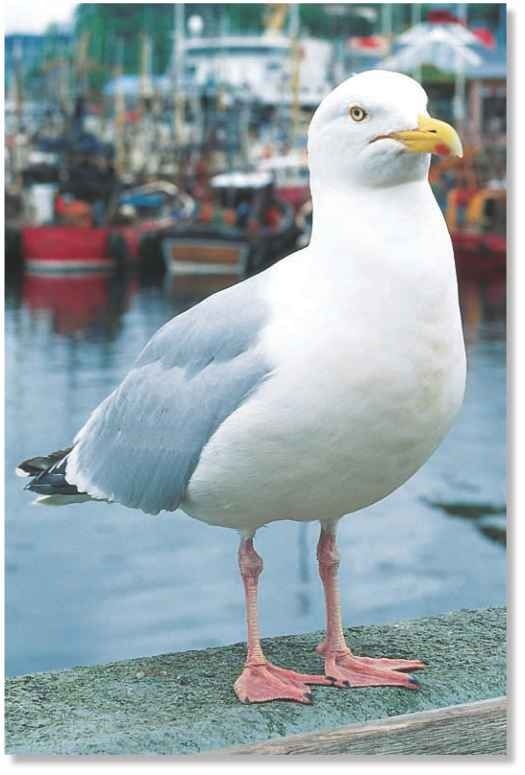ORDER
Charadriiformes
FAMILY
Laridae
GENUS & SPECIES
KEY FEATURES
• A versatile feeder that takes carrion and scraps as well as live
prey, which it hunts ; with great skill and expertise
• A bold bird prepared to take advantage of the many feeding and nesting opportunities provided by humans
• Gregarious and lives in flocks, yet it fiercely defends a small breeding territory from unwanted intruders
WHERE IN THE WORLD?
Breeds in North America, coastal Europe and northern Asia; some stay in the north for winter; others migrate to Iberia, the West Indies, Central America and coasts of the South China Sea
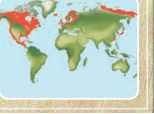
Lifecycle
A fierce predator and effective scavenger, the herring gull is one of the most successful and abundant gulls in the world as a result of its flexible and opportunistic feeding habits.
HABITAT
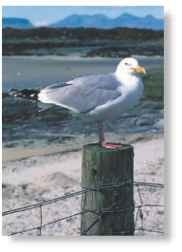
A Posted ashore Most herring gulls live on or near the coast.
The herring gull is seldom seen a long way from the coast. It breeds mainly on rocky islands and cliffs, but on flatter coasts, may nest on sand dunes. Herring gulls even nest on tundra and high moorland. This sociable gull doesn’t shy away from humans and nests freely on buildings in coastal towns and seaports.
In autumn, herring gulls that live in the far north of their range migrate south in search of food. Elsewhere, many birds stay at their breeding areas or move inland to fields, lakes or parks.
• The herring gull attacks puffins in the air, throwing them to the ground to kill them and eat them.
• Although good swimmers, herring gulls rarely dive and submerge completely.
• The herring gull is often referred to as the “seagull.”
• Other gull species, including glaucous gulls, interbreed with herring gulls.
BREEDING
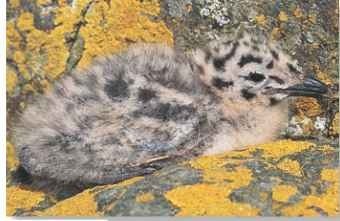
CHICK FEED
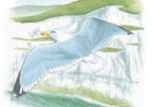
On patrol…
Catching coastal updrafts to soar effortlessly for long periods, a gull scans the ground below, looking for food for its chicks.
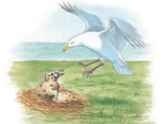
Waiting patiently…
A chick waits patiently for the adult bird to return home with a meal. At this early stage, it relies entirely on both parents for food.
BEHAVIOR
Outside the breeding season, the herring gull spends much of its time in loose flocks, which often contain several hundred birds and occasionally several thousand. These flocks may be made up of herring gulls alone, but may have a variety of gull species. A flock gathers to roost up to three hours before sunset. When roosting, the birds usually keep a distance of at least 1′ from each other to avoid fights and squabbles breaking out over individuals’ space.
Herring gulls can be extremely aggressive toward one another; especially in the breeding season when unattended eggs or chicks are snatched by gulls in the breeding colony Usual aggressive behavior involves snapping at an intruder’s wings or an upright warning posture directed to a potential nest robber: A herring gull advances on an intruder with wings held away from the body and bill held down as though about to lunge. The intruder usually backs down and the nest owner looks away, pecking and pulling at the grass where the other bird stood, as if exacting ritualized punishment.

When airborne, the gull flaps its gently bowed wings with deep, but lazy, beats or soars on the breeze with wings outstretched.
Preening time The gull conditions and cleans its plumage by preening. A preen gland on the rump has oil that the gull spreads through its feathers.
Herring gulls normally breed in colonies or as solitary pairs on undisturbed sloping ground, cliff tops and islands, but they may also choose inland sites on buildings and near lakes. Gulls pair for life and each year build a new nest out of vegetation and claim a small territory around it, which the pair defends fiercely.
Two or three eggs are laid by the female and incubated for four weeks by both parents. When the young hatch, at intervals of two or three days, they’re covered in down. They remain in the nest for a few days and are fed and cared for by both parents. The chicks don’t move far from the nest, staying in the home patch. The young take about six weeks to fledge and become fully independent about one or two weeks later.
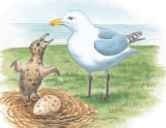
Feed me now…
Rising up, the chick tries to tap the red spot on its parent’s mandible. This indicates that it’s hungry and wants to be fed.
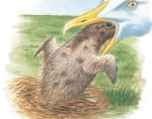
Fast food
In response, the adult regurgitates the food from its crop, opening its bill wide so the chick can reach right in to feed.
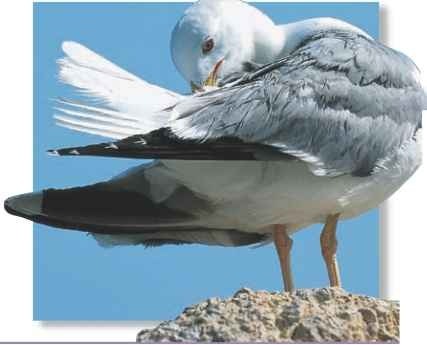
FOOD & FEEDING
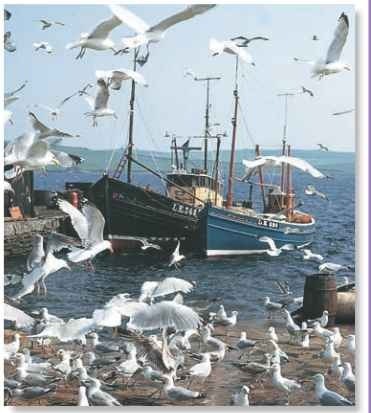
A Hangers on Gulls follow fishing boats, finding easy meals from discarded fish offal.
The gull is an opportunist that kills live prey, scavenges for carrion and scraps, steals food and feeds on vegetation.
On land, the gull walks in search of food, occasionally paddling the ground with its feet to bring invertebrates to the surface. Birds’ eggs and chicks are plucked from their nests; shellfish are i caught on the shoreline. The gull also hunts small rodents. \ Garbage dumps are another important source of food, and ‘ flocks of herring gulls are frequent visitors inland. To catch fish, the gull either swoops down on its prey when in flight or, while swimming, ducks its head and neck into the water to grab a passing victim.
CONSERVATION
The herring gull is one of the most abundant coastal birds in North America and Europe. Due to its habit of preying on young birds, it’s considered a pest in some parts of its range.
PROFILE
Herring Gull
The large and heavily built herring gull is a versatile bird, equally equipped to soar the skies, “sail” the seas and stroll about on the ground.
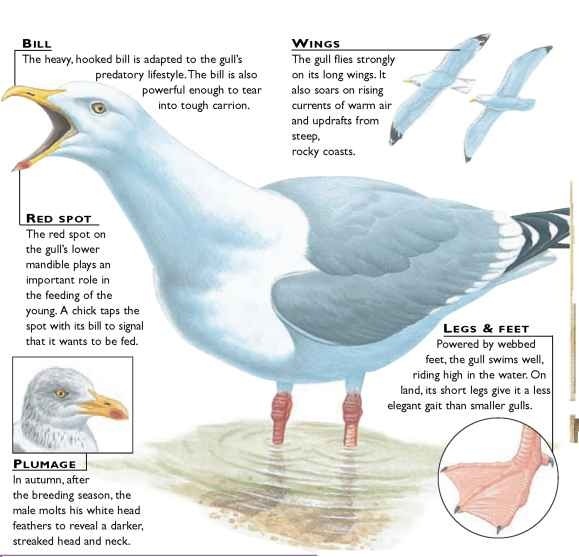
CREATURE COMPARISONS
Even the larger male herring gulls are dwarfed by the great black-backed gull, Larus marinus, which may reach 2.5′ from head to tail. More powerfully built than the herring gull, the great black-backed gull’s head and neck are thickset and its wingbeats are very deep and powerful.
In the breeding season, the predatory grea black-backed gull feeds almost exclusively on seabirds and, if available, small mammals. It also frequents dumps and scavenges around fishing ports for scraps.
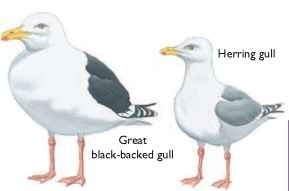
| VITAL | |
| STATISTICS | |
| Weight | 1.5-3 lbs. |
| Length | 1.8-2.2′ |
| Wingspan | 4-5′ |
| Sexual Maturity | 3-7 years; usually 5 years |
| Breeding Season | April-June |
| Number of Eggs | 2 or 3 |
| Incubation Period | 28-30 days |
| Fledging Period | 40-45 days |
| Breeding Interval | 1 year |
| Typical Diet | Fish, shellfish, worms; small mammals, birds; plant matter; scraps |
| Lifespan | Up to 32 years |
RELATED SPECIES
• The herring gull is one of 47 gull species in the family Laridae. Another member is the striking swallow-tailed gull, Creagrus furcatus (below), from the Galapagos Islands. The herring gull’s relations in the order Charadriiformes include terns and skuas.

